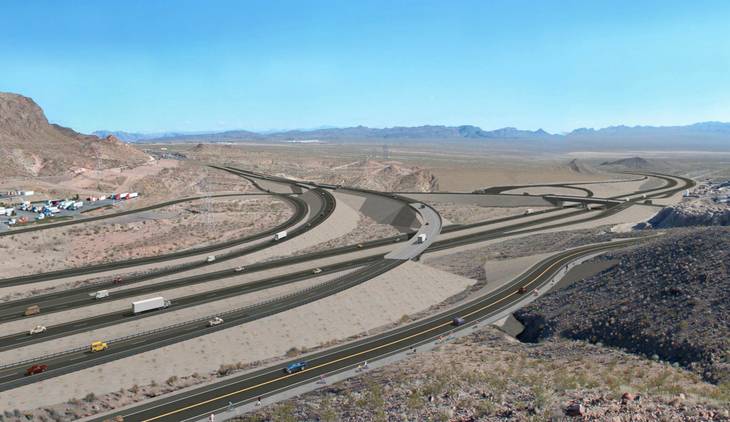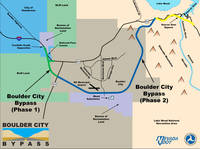Transportation experts say a 15-mile toll-road bypass around Boulder City would only be used by about 44 percent of the motorists using what eventually would become a piece of the proposed Interstate 11 between Hoover Dam and Henderson.
Representatives of the Nevada Department of Transportation and the Clark County Regional Transportation Commission tried to reassure a skeptical crowd of about 50 people attending a public hearing Wednesday that a four-lane freeway bypassing Boulder City would still achieve the goal of reducing traffic on the city’s streets.
Transportation officials took testimony and answered questions during a three-hour open house and public meeting at Boulder City High School.
The estimate that 44 percent of the traffic would use the bypass is based on studies by the Las Vegas-based Louis Berger Group, which was tasked with analyzing prospective toll structures to determine what price point would guarantee maximum revenue.
The estimate was based on a toll of $2.25 per passenger vehicle. Large trucks and commercial vehicles would potentially pay more.
The study was one component of the analysis to determine whether the bypass route would become Nevada’s first toll road. The Nevada Legislature would still have to approve legislation permitting a toll and is expected to consider that in the session that begins next month.
A measure approved by lawmakers in 2011 allowed NDOT to study the tolling concept.
The 15-mile route has been proposed in two phases and would dip to the south of Boulder City near the Railroad Pass casino. The route would continue east in flat desert terrain, then veer north through the Eldorado Mountains, rejoining what is now U.S. 93 near the Hacienda casino.
Engineers envision two open-road tolling express lanes per direction for electronic toll collections and three cash and credit lanes per direction for payment by machines at toll-booth plazas that would be built south of the city.
The reason the majority of motorists aren’t expected to use the toll road is that they’d have the option of using the existing U.S. 93 route through Boulder City that would remain free.
NDOT officials said the proposed $2.25 toll could be used the first year of operation, then modified up or down, depending on whether there was a need to increase or decrease demand.
Phase 1 of the project, which would be under the jurisdiction of NDOT, is a short piece that would run from Railroad Pass to a new intersection at U.S. 95 and cost between $20 million and $30 million for right-of-way and $90 million to $110 million for construction. Some of that land, in the Jericho Heights area, currently is the subject of contentious condemnation proceedings.
The longer Phase 2 portion of the highway, where the tolling would occur, is under the RTC’s jurisdiction and would cost about $330 million to complete. It’s on public land and wouldn’t require right-of-way acquisitions.
One of the benefits of allowing tolling is that the bypass would be completed faster. Officials estimate that if tolling were allowed, the project could be completed by 2018 or 2019 with an accelerated construction schedule.
If tolling isn’t allowed, the project would go on a list of future projects with an uncertain completion timetable. Because the route is part of the recently designated I-11 corridor, it would be completed eventually.
Some Boulder City residents attending Wednesday’s meeting are still questioning whether the bypass is necessary. They fear a drop in business in town if motorists bypass them, reduced access to desert lands by horsemen and outdoor recreation enthusiasts and a detrimental impact on desert wildlife, including desert tortoise and bighorn sheep.
An environmental impact study already has been completed on the route and engineers would be required to mitigate impacts to the area based on those requirements.
Comments can be still be submitted on the bypass project by Feb. 1. They can be submitted by email to Senior Project Manager Tony Lorenzi at [email protected] or to the Nevada Department of Transportation at 1263 S. Stewart St., Carson City, 89712.

